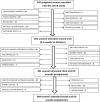Association between infection and nutritional status among infants in a cohort study of vitamin A in western Kenya
- PMID: 36211493
- PMCID: PMC9537535
- DOI: 10.3389/fnut.2022.921213
Association between infection and nutritional status among infants in a cohort study of vitamin A in western Kenya
Abstract
Background: Infection is associated with impaired nutritional status, especially for infants younger than 5 years.
Objectives: We assessed the impact of infection indicated by both acute phase proteins (APP), C-reactive protein (CRP), and α-1-acid-glycoprotein (AGP), and as reported by maternal recall on the nutritional status of infants.
Materials and methods: A total of 505 pregnant women were enrolled in a nested longitudinal cohort study of vitamin A (VA). Data from 385 children are reported here. The incidence and severity of respiratory infection and diarrhea (previous 14 days) were assessed by maternal recall; infant/child feeding practices were collected. Infant weight, recumbent length, and heel-prick capillary blood were taken at 9 months postpartum. Indicators of the VA status [retinol binding protein (RBP)], iron status (Hb, ferritin), and subclinical inflammation APP, CRP (>5 mg/L), and AGP (>1 g/L) were determined. Impacts of infection on the infant nutritional status were estimated using logistic regression models.
Results: Infection prevalence, based on elevated CRP and AGP levels, was 36.7%. For diarrhea reported symptoms, 42.4% of infants at 9 months had no indication of infection as indicated by CRP and AGP; for acute respiratory reported symptoms, 42.6% had no indication of infection. There was a significant positive association with infection among VA-deficient (RBP < 0.83 μmol/L) infants based on maternal reported symptoms but not with iron deficiency (ferritin < 12 μg/L). The odds of having infection, based on increased CRP and AGP, in underweight infants was 3.7 times higher (OR: 3.7; 95% CI: 2.3, 4.5; P = 0.019). Infants with iron deficiency were less likely (OR: 0.40; 95% CI: 0.1, 0.7; P = 0.001) to have infection based on CRP and AGP, while infants with VA deficiency were five times more likely (OR: 5.06; 95% CI: 3.2, 7.1; P = 0.0001) to have infection.
Conclusion: Acute phase proteins are more useful in defining infection in a population than reported symptoms of illness. Not controlling for inflammation in a population while assessing the nutritional status might result in inaccurate prevalence estimation.
Keywords: infants; infection; inflammation; iron deficiency; vitamin A deficiency.
Copyright © 2022 Grant, Wanjala, Low, Levin, Cole, Okuku, Ackatia-Armah and Girard.
Conflict of interest statement
The authors declare that the research was conducted in the absence of any commercial or financial relationships that could be construed as a potential conflict of interest.
Figures
Similar articles
-
Estimation of the effect of the acute phase response on indicators of micronutrient status in Indonesian infants.J Nutr. 2002 Oct;132(10):3061-6. doi: 10.1093/jn/131.10.3061. J Nutr. 2002. PMID: 12368396 Clinical Trial.
-
Correcting for inflammation changes estimates of iron deficiency among rural Kenyan preschool children.J Nutr. 2012 Jan;142(1):105-11. doi: 10.3945/jn.111.146316. Epub 2011 Dec 7. J Nutr. 2012. PMID: 22157541 Free PMC article.
-
Vitamin A and iron status of children before and after treatment of uncomplicated severe acute malnutrition.Clin Nutr. 2020 Nov;39(11):3512-3519. doi: 10.1016/j.clnu.2020.03.016. Epub 2020 Mar 24. Clin Nutr. 2020. PMID: 32249112 Clinical Trial.
-
Adjusting retinol-binding protein concentrations for inflammation: Biomarkers Reflecting Inflammation and Nutritional Determinants of Anemia (BRINDA) project.Am J Clin Nutr. 2017 Jul;106(Suppl 1):390S-401S. doi: 10.3945/ajcn.116.142166. Epub 2017 Jun 14. Am J Clin Nutr. 2017. PMID: 28615251 Free PMC article. Review.
-
Iron, zinc, vitamin A and selenium status in a cohort of Indonesian infants after adjusting for inflammation using several different approaches.Br J Nutr. 2017 Nov;118(10):830-839. doi: 10.1017/S0007114517002860. Br J Nutr. 2017. PMID: 29189196
Cited by
-
The association between serum vitamin A concentrations and virus hepatitis among U.S. adults from the NHANES database: a cross-sectional study.Front Nutr. 2024 Aug 1;11:1387461. doi: 10.3389/fnut.2024.1387461. eCollection 2024. Front Nutr. 2024. PMID: 39149555 Free PMC article.
-
Nutritional Deficiencies and Oral Candidiasis in Children from Northeastern Romania: A Cross-Sectional Biochemical Assessment.Nutrients. 2025 May 27;17(11):1815. doi: 10.3390/nu17111815. Nutrients. 2025. PMID: 40507084 Free PMC article.
-
Risk factors for acute respiratory infection among children in Yemen: a hospital based matched case-control study.BMC Pediatr. 2025 Jul 4;25(1):528. doi: 10.1186/s12887-025-05880-6. BMC Pediatr. 2025. PMID: 40615774 Free PMC article.
-
Micronutrient and Nutritional Status of HIV-Exposed and HIV-Unexposed Malawian Infants in the First Year of Life: Assessment of Ferritin, Vitamin A, and D Status and Its Association with Growth.Nutrients. 2023 Jul 24;15(14):3282. doi: 10.3390/nu15143282. Nutrients. 2023. PMID: 37513701 Free PMC article.
References
LinkOut - more resources
Full Text Sources
Research Materials
Miscellaneous


